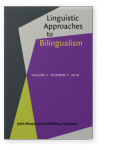Commentary
How constrained is language mixing in bi- and uni-modal production?
References (16)
References
Chan, B.H.-S. (2008). Code-switching, word order, and the lexical/functional category distinction. Lingua, 118, 777–809. 

Deuchar, M., & Biberauer, T. (2016). Doubling: An error or an illusion? Bilingualism: Language and Cognition, 19(5), 881–882. 

Goldrick, M., Putnam, M., & Schwarz, L. (2016a). Coactivation in bilingual grammars: A computational account of code mixing. Bilingualism: Language & Cognition, 19(5), 857–876. 

Goldrick, M., Putnam, M., & Schwarz, L. (2016b). The future of code mixing research: Integrating psycholinguistic and formal grammar theories. Bilingualism: Language and Cognition, 19(5), 903–906. 

Kroll, J., & Gollan, T. (2014). Speech planning in two languages: What bilinguals tell us about language production. In: M. Goldrick, V. Ferreira, & M. Miozzo (Eds.), The Oxford handbook of language production (pp. 165–181). Oxford: Oxford University Press.
Legendre, G., Putnam, M., de Swart, H., & Zaroukian, E. (2016). Introduction. In: G. Legendre, M. Putnam, H. de Swart, & E. Zaroukian (Eds.), Optimality-theoretical syntax, semantics, and pragmatics: From uni- to bidirectional optimization (pp. 1–33). Oxford: Oxford University Press. 

Legendre, G., & Schindler, M. (2010). Code Switching in Urban Wolof: A Case for Violable Constraints in Syntax. Revista Virtual de Estudos da Linguagem (ReVEL), 8:4 (Special Issue on Optimality Theoretic Syntax). Online at [URL].
MacSwan, J. (2013). Code switching and linguistic theory. In: T.K. Bhatia & W. Ritchie (Eds.), Handbook of bilingualism and multilingualism (pp. 223–250). Oxford: Blackwell.
Myers-Scotton, C. (1993). Duelling Languages: Grammatical structure in codeswitching. New York: Oxford University Press.
Poplack, S., Wheeler, S., & Westwood, A. (1989). Distinguishing language-contact phenomena evidence from Finnish-English bilingualism. World Englishes, 8, 389–406. 

Poplack, S., & Torres Cacoullos, R. (2016). Data before models. Bilingualism: Language and Cognition, 19(5), 893–894. 

Sankoff, D., Poplack, S., & Vannianiarajan, S. (1990). The case of the nonce loan in Tamil. Language Variation and Change, 2, 71–101. 

Schoonbaert, S., Hartsuiker, R.J., & Pickering, M.J. (2007). The representation of lexical and syntactic information in bilinguals: Evidence from syntactic priming. Journal of Memory and Language, 56, 153–171. 

Smolensky, P., Goldrick, M., & Mathis, D.. (2014). Optimization and quantization in gradient symbol systems: A framework for integrating the continuous and the discrete in cognition. Cognitive Science, 38, 1102–1138. 

van den Bogaerde, B., & Baker, A.E. (2008). Bimodal language acquisition in kodas. In: M. Bishop & S.L. Hicks (Eds.), HEARING, MOTHER FATHER DEAF: hearing people in Deaf families (pp. 99–131). Washington, DC: Gallaudet University Press.
Cited by (2)
Cited by two other publications
López, Luis
2020.
Bilingual Grammar,

Putnam, Michael T. & Robert Klosinski
This list is based on CrossRef data as of 16 september 2024. Please note that it may not be complete. Sources presented here have been supplied by the respective publishers.
Any errors therein should be reported to them.
